
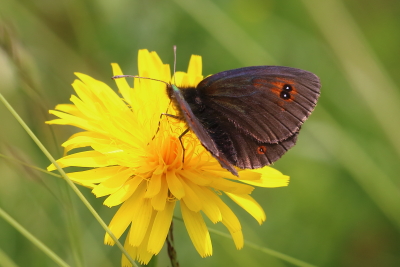
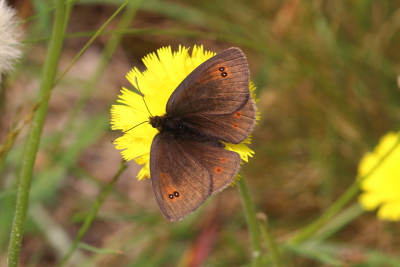
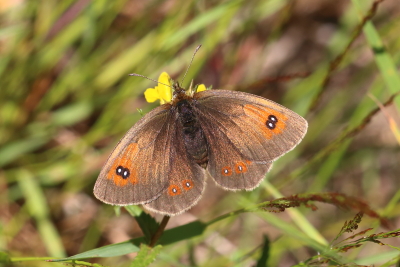
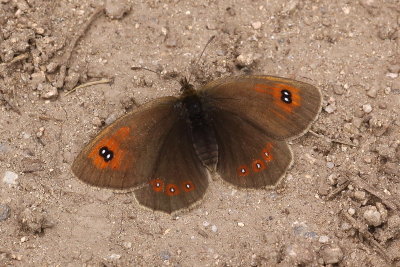
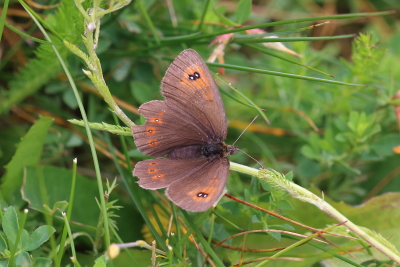
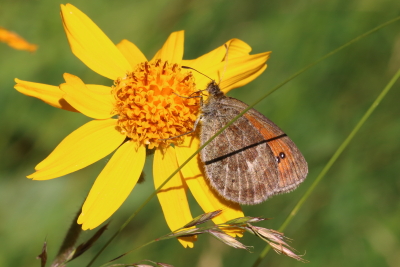
38410_male_Lozčre_12Jul15
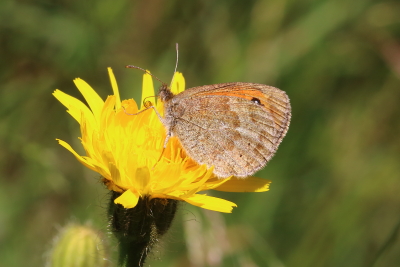
38456_female_Lozčre_12Jul15
38466_female_Lozčre_12Jul15
Ottoman Brassy ringlet (Erebia ottomana)
2024 photographs highlighted in yellow. Click on any photograph to go to an enlarged picture, or simply scroll down the page.
|
A species predominantly from, as its name suggests, Asia minor but with a very limited and highly localised presence in France in the Cévennes at the southern end of the huge region described as the Massif Central, but only in two locations. The French subspecies is tardenota.
It is relatively small species, in common with the other species of brassy ringlet, and flies (according to Lafranchis) at 1100-1500m, although on the one occasion I have seen it, it was slightly above this range.
Lafranchis says that the defining feature, compared to other Erebia species in the same localities, is the two brown bands on the unh. I'm not sure I entirely concur, based albeit on very limited experience, in that the male underside is clearly grey rather than brown (the male underside in T&L is also clearly grey), and the two females I saw in 2015 were rather different, one having a distinctive discal line and band, the other having very little contrast. |
It is said, and I do not know whether it is true in all cases, that no two species of Brassy Ringlet fly together, so it should follow that if one ottomana can be identified with confidence, then any other Brassy Ringlet from the same location should also be ottomana. In 2015 it proved very difficult to get any sort of decent photo of this species, as these rather poor photographs attest. Erebia species have a tendency to settle low in grass, but on the day of my visit, it was hot and windy, making all the Erebia at the location very active and when they did settle, it was on on grass stems that waved around in the breeze. However, the butterfly gods sometimes reward persistence, and I revisited the site in 2017 and sat for several hours in light drizzle in an overcast sky; there was a brief spell in the early afternoon of weak sun and no rain, and the whole region came to life, with 43624 obligingly sitting still and opening up to absorb whatever heat from the sun that it could. A more recent visit to the same site in 2023 on 13 July was rewarded with very good numbers, maybe 50 or more on the wing, mostly fresh-looking females as evidenced by the 2023 images. |
|
ref |
sex |
observations |
alt. m |
| 43624 | M | a fresh male, a very fortunate opportunity to get a open wing shot of a still subject. Even luckier, there was no wind. | 1540 |
| 51556 | M | a male, rather dark brown ground colour. | 1540 |
| 51570 | M | a male, rather lighter brown ground colour but perhaps due to wear as the slightly worn fringes attest. | 1540 |
| 51519 | F | a female, quite fresh and distinctly brassy. | 1540 |
| 51558 | F | a very fresh female, a quick snap as it settled momentarily on the ground. | 1540 |
| 48526 | F | a female, with a little ageing and wing damage, but upperside shots of female ottomana don't present themselves very often. | 1540 |
|
38410 |
M |
a male, even more hyperactive than the females. |
1540 |
| 51520 | M | a male underside. It wasn't the stem of grass that obscured the shot, more the shadow of it. | 1540 |
| 51510 | F | a female underside, quite brown in colour and with some contrast across the discal line. | 1540 |
|
38456 |
F |
a female with a fairly well defined discal line and contrast across it. |
1540 |
|
38466 |
F |
a female, with no discernible discal line. Compare to 38456 and to the illustration in T&L. |
1540 |